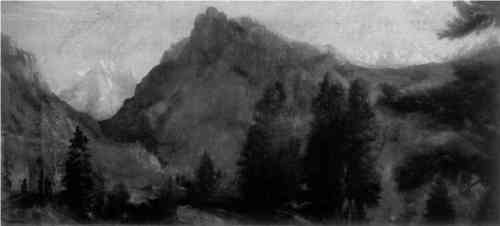ARTHUR B. DAVIES'S MOUNTAIN BELOVED OF SPRING: DETERMINING TREATMENT BY RECONSTRUCTING A PAINTING'S HISTORYNANCY R. POLLAK
1 INTRODUCTIONIn June 1993, the Addison Gallery of American Art, a member of the Williamstown Art Conservation Center, requested an examination and treatment proposal for a painting in its collection. Mountain Beloved of Spring (ca. 1906–7), by Arthur Bowen Davies, was the first painting to be included in the Addison's collection (fig. 1). Influenced by Davies's trip west in 1905, the imagery is probably based in the Rocky Mountains.
The painting was scheduled for an upcoming exhibition, but cosmetic problems, including what appeared to be a thick grime layer and discolored varnish, disfigured the image. While the painting appeared to be structurally sound, a bulge in the lower left corner indicated some problems with the stretching tension in the canvas. The treatment of the painting was assigned to the author, and the standard examination was carried out. Techniques used in the examination included study in specular, raking, and ultraviolet light and under low-power magnification, as well as microcleaning tests performed in representative areas of the painting. Materials and methods of construction were estimated, condition was summarized, and a course of treatment was proposed. 1.1 CONSTRUCTION AND CONDITION OF THE PAINTINGThe painting was executed on a fine-weight, balanced-weave linen canvas with a thread count of 54 threads/in. in both the horizontal and vertical directions. No selvages were present to distinguish warp and weft. The canvas was secured by tacks to a five-membered stretcher with wooden panel inserts. A second set of tack holes was present in both the tacking edge and the stretcher. A thin, gauzelike material was visible beneath damages in the tacking edge and appeared to be attached to the original canvas with paste or glue. The panels in the stretcher prevented identification of this addition as a full or strip lining. Although the composition extended slightly over the top tacking edge and covered the bottom tacking edge, there was no evidence of other fold lines or tack holes to suggest that the dimensions of the painting had been altered after it had left the artist's hands. Structurally, the painting was in very good condition. A slight bulge in the lower left corner was caused by an accumulation of debris between the canvas and stretcher and by improper stretching tension. The canvas in the The canvas appeared to be commercially preprimed, and the priming extended evenly to the cut edges. The thinly applied ground did not fill the canvas weave, which remained visible at the unpainted tacking edges and through thinner paint passages. The paint layers appeared to be composed of oil-bound paint varying from multiple thin layers, some of which were rubbed into the canvas, to thicker paint strokes that had low but appreciable body and texture. Microscopic observation and cleaning tests showed no evidence of solvent-sensitive paint layers, and interlayered varnish or resin-bound glazes were not observed. Examination of the paint surface under the microscope indicated some surface abrasion on high points of the canvas and darker pools of varnish in weave interstices, suggesting that the painting had undergone varnish removal or reduction in the past, possibly in conjunction with the structural treatment. The paint surface was covered with a very thick, yellowed varnish coating composed primarily of natural resin, with a topmost synthetic resin layer. The varnish imparted a dull yellow color to the image, and its surface was crizzled in areas with irregular gloss. In ultraviolet light, the painting autofluoresced yellow-green overall, with some duller areas mottling the surface. These mottled areas were mostly in the sky, corresponding to dull areas seen in natural light, and were presumed to be retouching intermixed with varnish layers. Only a few discrete, nonfluorescent areas, indicative of recent retouching, were apparent. The varnish surface bore multiple layers of grime ranging from a dusty gray grime layer to a yellow-brown layer suggestive of tobacco smoke residue. 1.2 PROPOSED TREATMENTThe proposed treatment included restretching the canvas in the lower left corner to locally address the planar deformation, removing surface grime and reducing or removing discolored varnish. Cleaning tests indicated that the varnish dissolved readily, without affecting the underlying paint. In areas tested, the removal of grime and reduction of varnish produced a significant improvement in the color and clarity of the underlying paint. It was presumed that retouchings on the surface and intermixed retouchings would be removed with the varnish. Lower pooled residues and more tenacious localized overpaint would then be reduced as possible, with remaining residues cosmetically corrected by retouching. 1.3 INITIAL TREATMENTThe treatment, accepted as proposed, was begun following photographic documentation. Overall grime was removed from the varnish surface with naphtha soap (5 parts naphtha emulsified with 2 parts triethanolamine and 5 parts oleic acid in 5 parts water) cleared with xylene. Although not usually used to clear naphtha soap, xylene was chosen in this instance because it also removed the uppermost synthetic varnish, exposing the discolored natural resin varnish. This natural resin varnish was very yellow, thick, and irregularly glossy, as observed in the initial examination. The composition appeared flat, with little distinction among compositional elements, especially in the sky and distant mountains. At this time, the varnish still appeared to be a final layer applied somewhat evenly over the entire paint surface. The goal of the varnish removal was to slowly reduce the varnish overall, stopping when the disturbing effects of the varnish were satisfactorily diminished. A free solvent of 2-propanol was used, but as the varnish began to be reduced, two distinct zones appeared in the painting: one comprising the |
